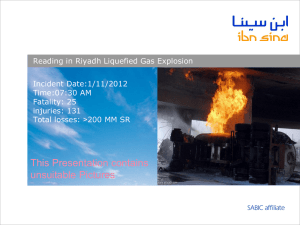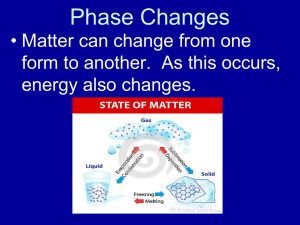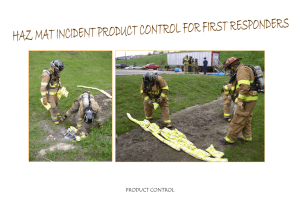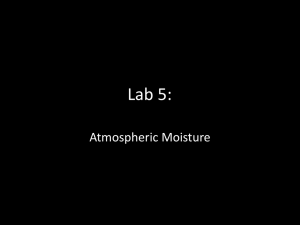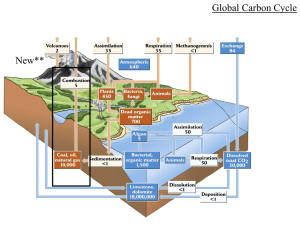Water vapor pressure
advertisement
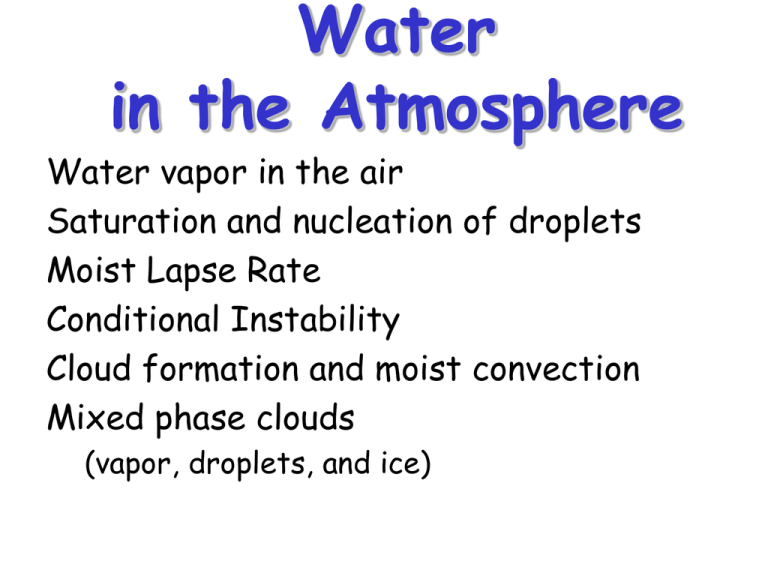
Water in the Atmosphere Water vapor in the air Saturation and nucleation of droplets Moist Lapse Rate Conditional Instability Cloud formation and moist convection Mixed phase clouds (vapor, droplets, and ice) Molecular Structure of Water water molecule ice Water's unique molecular structure and hydrogen bonds enable all 3 phases to exist in earth's atmosphere. “Latent” (hidden) Energy associated with phase changes Why does it take so much energy to evaporate water? • In the liquid state, adjacent water molecules attract one another • This same hydrogen bond accounts for surface tension on a free water surface “plus” charge on hydrogen in one water molecule attracts the “minus” charge on a neighbor’s oxygen column of water “sticks together” Water vapor saturation • Water molecules move between the liquid and gas phases • When the rate of water molecules entering the liquid equals the rate leaving the liquid, we have equilibrium – The air is said to be saturated with water vapor at this point – Equilibrium does not mean no exchange occurs Water vapor pressure • Molecules in an air parcel all contribute to pressure • Each subset of molecules (e.g., N2, O2, H2O) exerts a partial pressure • The VAPOR PRESSURE, e, is the pressure exerted by water vapor molecules in the air – similar to atmospheric pressure, but due only to weight of all the water vapor molecules above you Saturation and Temperature • The saturation vapor pressure of water increases with temperature – At higher T, faster water molecules in liquid escape more frequently causing equilibrium water vapor concentration to rise – We sometimes say “warmer air can hold more water” • There is also a vapor pressure of water over an ice surface – The saturation vapor pressure above solid ice is less than above liquid water Water vapor is not evenly distributed throughout the atmosphere • Generally largest amounts are found close to the surface, decreasing aloft – Closest to the source - evaporation from ground, plants, lakes and ocean – Warmer air can hold more water vapor than colder air “Relative Humidity” • Relative Humidity (RH) is ratio of actual vapor pressure to saturation vapor pressure – 100 * e/eS – Range: 0-100% (+) – Air with RH > 100% is supersaturated • RH can be changed by – Changes in water vapor content, e – Changes in temperature, which alter eS Ways to express the amount of water vapor in an air parcel • Absolute humidity – mass of water vapor/volume of air (g/m3) – changes when air parcel volume changes • Mixing ratio – mass of water vapor/mass of dry air (g/kg) • Absolute humidity and mixing ratio remain constant as long as water vapor is not added/removed to/from air parcel • Dew point temperature Dew • Surfaces cool strongly at night by radiative cooling – Strongest on clear, calm nights • The dew point is the temperature at which the air is saturated with water vapor • If a surface cools below the dew point, water condenses on the surface and dew drops are formed • Dew does not “fall” Dewpoint Temperatures • If air cools to its dewpoint, then dew will form • Dewpoint is a measure of the water vapor content • It is not a measure of temperature! Which environment has higher water vapor content? MORE WATER VAPOR! LESS WATER VAPOR! Condensation • Phase transformation of water vapor to liquid water • Water does not easily condense without a surface present – Vegetation, soil, buildings provide surface for dew and frost formation – Particles act as sites for cloud and fog drop formation Cloud and fog drop formation • If the air temperature cools below the dew point (RH > 100%), water vapor will tend to condense and form cloud/fog drops • Drop formation occurs on particles known as cloud condensation nuclei (CCN) • The most effective CCN are water soluble • Without particles clouds would not form in the atmosphere! – RH of several hundred percent required for pure water drop formation Cloud Droplets are Tiny! Very Small Drops Evaporate! • Surface of small drops are strongly curved • Stronger curvature produces a higher esat • Very high RH required for equilibrium with small drops – ~300% RH for a 0.1 µm pure water drop If small drops evaporate, how can we ever get large drops?! Nucleation of Cloud Droplets • Formation of a pure water drop without a condensation nucleus is termed “homogeneous nucleation” • Random collision of water vapor molecules can form a small drop embryo – Collision likelihood limits maximum embryo size to < 0.01 µm • esat for embryo is several hundred percent – Embryo evaporates since environmental RH < 100.5% Effects of Dissolved Stuff • Condensation of water on soluble CCN dissolves particle – Water actually condenses on many atmospheric salt particles at RH ~70% • Some solute particles will be present at drop surface – Displace water molecules – Reduce likelihood of water molecules escaping to vapor – Reduce esat from value for pure water drop Water molecule Solute molecule Steps in Cloud/Fog Formation • Air parcel cools causing RH to increase – Radiative cooling at surface (fog) – Expansion in rising parcel (cloud) • CCN (tenths of µm) take up water vapor as RH increases – Depends on particle size and composition • IF RH exceeds critical value, drops are activated and grow readily into cloud drops (10’s of µm) Cloud Condensation Nuclei • Not all atmospheric particles are cloud condensation nuclei (CCN) • Good CCN are hygroscopic (“like” water, in a chemical sense) • Many hygroscopic salt and acid particles are found in the atmosphere • Natural CCN – Sea salt particles (NaCl) – Particles produced from biogenic sulfur emissions – Products of vegetation burning • CCN from human activity – Pollutants from fossil fuel combustion react in the atmosphere to form acids and salts

